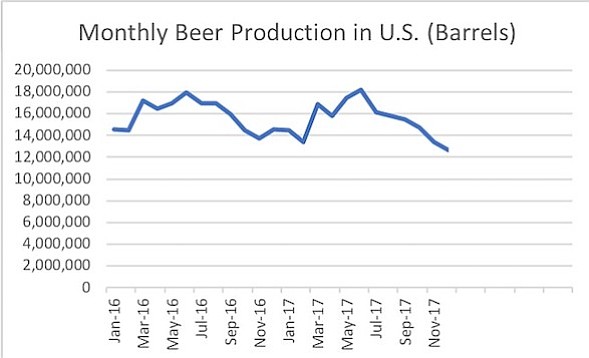 Facebook
Facebook
 X
X
 Instagram
Instagram
 TikTok
TikTok
 Youtube
Youtube

Statistics released by the U.S. Treasury bureau that regulates sales of alcohol indicate that, in 2017, beer production in the U.S. dropped by its highest rate in 14 years — 2.75 percent — to its lowest overall volume in at least three decades.
The statistics, published March 1st by the Alcohol Tobacco Tax and Trade Bureau, compile numbers reported directly by all licensed breweries in the U.S. The bureau’s statistics show brewers reported producing just over 185 million barrels in the 2017 calendar year, a nearly 5 million barrel drop from the roughly 190 million barrels produced in 2016.
According to archival bureau reports, annual U.S. beer production has not stood below 190 million barrels per year since prior to 1986, its earliest annual records currently published online. While annual production surpassed 200 million barrels several times in the 1990s, it's reached that number just once this century — in 2002 — before correcting with a 2.8 percent drop the following year, to 195 million barrels.
The numbers have fluctuated since, but trended down, including a 2.1 percent drop in 2013. They have been relatively stagnant since 2014.
These figures reflect all beer produced in the U.S., including both legacy macro-beer producers such as Anheuser-Busch and MillerCoors, and the independent craft breweries that have proliferated locally. Leading up to 2017, the downward trend could be attributed to a modest decline in production by macro breweries that still control over 85 percent of the $106.7 billion beer market.
It's too soon to say whether last year's decline in overall production predicts a decline in craft beer as well. While statistics maintained by the Brewers Association indicate that craft brewers have steadily increased both in overall production volume and market share over the past decade, that trend slowed in 2016, even as the number of craft breweries rose to over 6000.
Corporate acquisitions of high-profile, high-volume craft breweries in the past several years have held craft growth in check. According to Brewers Association statistics released last spring, the 24.6 million barrels produced by craft breweries in 2016 resulted in barely more than a 1 percent rise, following a decade averaging double-digit increases.
Updated craft-industry figures will likely be released by next month.
Meanwhile, corresponding monthly reports prepared by the Beer Institute, sourcing data from the U.S. Department of Commerce, show where some of that beer consumption has gone. While U.S. production has dropped 7.7 million barrels over the past three years, beer imports overall have increased by 5 million barrels in that time span. Leading the way by far is Mexico, which has added 4.6 million barrels during that time, importing 23 million barrels to the U.S. in 2017.


Statistics released by the U.S. Treasury bureau that regulates sales of alcohol indicate that, in 2017, beer production in the U.S. dropped by its highest rate in 14 years — 2.75 percent — to its lowest overall volume in at least three decades.
The statistics, published March 1st by the Alcohol Tobacco Tax and Trade Bureau, compile numbers reported directly by all licensed breweries in the U.S. The bureau’s statistics show brewers reported producing just over 185 million barrels in the 2017 calendar year, a nearly 5 million barrel drop from the roughly 190 million barrels produced in 2016.
According to archival bureau reports, annual U.S. beer production has not stood below 190 million barrels per year since prior to 1986, its earliest annual records currently published online. While annual production surpassed 200 million barrels several times in the 1990s, it's reached that number just once this century — in 2002 — before correcting with a 2.8 percent drop the following year, to 195 million barrels.
The numbers have fluctuated since, but trended down, including a 2.1 percent drop in 2013. They have been relatively stagnant since 2014.
These figures reflect all beer produced in the U.S., including both legacy macro-beer producers such as Anheuser-Busch and MillerCoors, and the independent craft breweries that have proliferated locally. Leading up to 2017, the downward trend could be attributed to a modest decline in production by macro breweries that still control over 85 percent of the $106.7 billion beer market.
It's too soon to say whether last year's decline in overall production predicts a decline in craft beer as well. While statistics maintained by the Brewers Association indicate that craft brewers have steadily increased both in overall production volume and market share over the past decade, that trend slowed in 2016, even as the number of craft breweries rose to over 6000.
Corporate acquisitions of high-profile, high-volume craft breweries in the past several years have held craft growth in check. According to Brewers Association statistics released last spring, the 24.6 million barrels produced by craft breweries in 2016 resulted in barely more than a 1 percent rise, following a decade averaging double-digit increases.
Updated craft-industry figures will likely be released by next month.
Meanwhile, corresponding monthly reports prepared by the Beer Institute, sourcing data from the U.S. Department of Commerce, show where some of that beer consumption has gone. While U.S. production has dropped 7.7 million barrels over the past three years, beer imports overall have increased by 5 million barrels in that time span. Leading the way by far is Mexico, which has added 4.6 million barrels during that time, importing 23 million barrels to the U.S. in 2017.
Comments